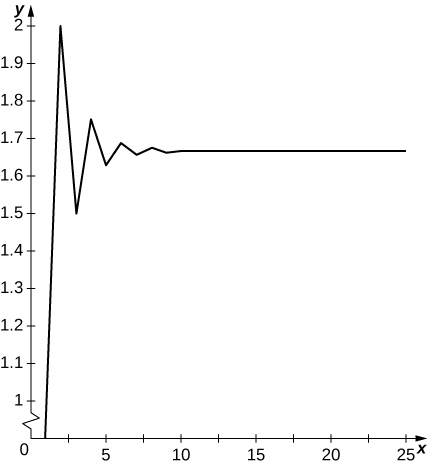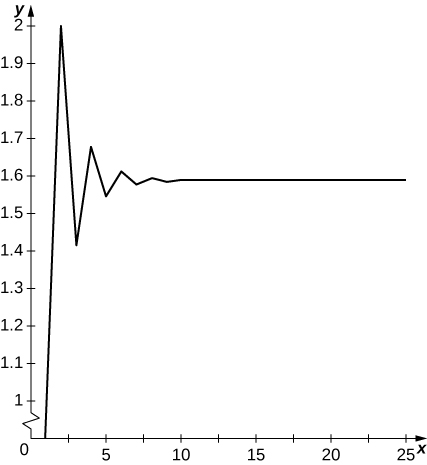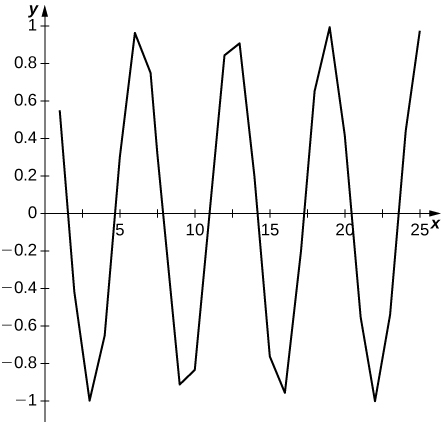1.2E: Exercises for Section 1.2
- Last updated
- Sep 11, 2021
- Save as PDF
- Page ID
- 83970
( \newcommand{\kernel}{\mathrm{null}\,}\)
In exercises 1 - 4, find the first six terms of each sequence, starting with n=1.
1) an=1+(−1)n for n≥1
- Answer
- an=0 if n is odd and an=2 if n is even
2) an=n2−1 for n≥1
3) a1=1 and an=an−1+n for n≥2
- Answer
- an=1,3,6,10,15,21,…
4) a1=1,a2=1 and an+2=an+an+1 for n≥1
5) Find an explicit formula for an where a1=1 and an=an−1+n for n≥2.
- Answer
- an=n(n+1)2
6) Find a formula an for the nth term of the arithmetic sequence whose first term is a1=1 such that an+1−an=17 for n≥1.
7) Find a formula an for the nth term of the arithmetic sequence whose first term is a1=−3 such that an+1−an=4 for n≥1.
- Answer
- an=4n−7
8) Find a formula an for the nth term of the geometric sequence whose first term is a1=1 such that an+1an=10 for n≥1.
9) Find a formula an for the nth term of the geometric sequence whose first term is a1=3 such that an+1an=1/10 for n≥1.
- Answer
- an=3.101−n=30.10−n
10) Find an explicit formula for the nth term of the sequence whose first several terms are 0,3,8,15,24,35,48,63,80,99,…. (Hint: First add one to each term.)
11) Find an explicit formula for the nth term of the sequence satisfying a1=0 and an=2an−1+1 for n≥2.
- Answer
- an=2n−1−1
In exercises 12 and 13, find a formula for the general term an of each of the following sequences.
12) 1,0,−1,0,1,0,−1,0,… (Hint: Find where sinx takes these values)
13) 1,−1/3,1/5,−1/7,…
- Answer
- an=(−1)n−12n−1
In exercises 14-18, find a function f(n) that identifies the nth term an of the following recursively defined sequences, as an=f(n).
14) a1=1 and an+1=−an for n≥1
15) a1=2 and an+1=2an for n≥1
- Answer
- f(n)=2n
16) a1=1 and an+1=(n+1)an for n≥1
17) a1=2 and an+1=(n+1)an/2 for n≥1
- Answer
- f(n)=n!2n−2
18) a1=1 and an+1=an/2n for n≥1
In exercises 19 - 22, plot the first N terms of the given sequence. State whether the graphical evidence suggests that the sequence converges or diverges.
19) [T] a1=1,a2=2, and for n≥2,an=12(an−1+an−2); N=30
- Answer
-
Terms oscillate above and below 5/3 and appear to converge to 5/3.

20) [T] a1=1,a2=2,a3=3 and for n≥4,an=13(an−1+an−2+an−3),N=30
21) [T] a1=1,a2=2, and for n≥3,an=√an−1an−2;N=30
- Answer
-
Terms oscillate above and below y≈1.57.. and appear to converge to a limit.

22) [T] a1=1,a2=2,a3=3, and for n≥4,an=√an−1an−2an−3;N=30
In exercises 23 - 16, suppose that limn→∞an=1, limn→∞bn=−1, and 0<−bn<an for all n.
Using this information, evaluate each of the following limits, state that the limit does not exist, or state that there is not enough information to determine whether the limit exists.
23) limn→∞3an−4bn
- Answer
- limn→∞3an−4bn=7
24) limn→∞12bn−12an
25) limn→∞an+bnan−bn
- Answer
- limn→∞an+bnan−bn=0
26) limn→∞an−bnan+bn
In exercises 27 - 30, find the limit of each of the following sequences, using L’Hôpital’s rule when appropriate.
27) n22n
- Answer
- limn→∞n22n=0
28) (n−1)2(n+1)2
29) √n√n+1
- Answer
- limn→∞√n√n+1=1
30) n1/n (Hint: n1/n=e1nlnn)
In exercises 31 - 37, state whether each sequence is bounded and whether it is eventually monotone, increasing, or decreasing.
31) n/2n,n≥2
- Answer
- bounded, decreasing for n≥1
32) ln(1+1n)
33) sinn
- Answer
- bounded, not monotone
34) cos(n2)
35) n1/n,n≥3
- Answer
- bounded, decreasing
36) n−1/n,n≥3
37) tann
- Answer
- not monotone, not bounded
In exercises 38 - 39, determine whether the given sequence has a limit. If it does, find the limit.
38) a1=√2,a2=√2√2.a3=√2√2√2 etc.
39) a1=3,an=√2an−1,n=2,3,….
- Answer
- an is decreasing and bounded below by 2. The limit a must satisfy a=√2a so a=2, independent of the initial value.
Use the Squeeze Theorem to find the limit of each sequence in exercises 40 - 43.
40) nsin(1/n)
41) cos(1/n)−11/n
- Answer
- 0
42) an=n!nn
43) an=sinnsin(1/n)
- Answer
- 0 since |sinx|≤|x| and |sinx|≤1 so −1n≤an≤1n).
For the sequences in exercises 44 and 45, plot the first 25 terms of the sequence and state whether the graphical evidence suggests that the sequence converges or diverges.
44) [T] an=sinn
45) [T] an=cosn
- Answer
-
Graph oscillates and suggests no limit.

In exercises 46 - 52, determine the limit of the sequence or show that the sequence diverges. If it converges, find its limit.
46) an=tan−1(n2)
47) an=(2n)1/n−n1/n
- Answer
- n1/n→1 and 21/n→1, so an→0
48) an=ln(n2)ln(2n)
49) an=(1−2n)n
- Answer
- Since (1+1/n)n→e, one has (1−2/n)n≈(1+k)−2k→e−2 as k→∞.
50) an=ln(n+2n2−3)
51) an=2n+3n4n
- Answer
- 2n+3n≤2⋅3n and 3n/4n→0 as n→∞, so an→0 as n→∞.
52) an=(1000)nn!
53) an=(n!)2(2n)!
- Answer
- an+1an=n!/(n+1)(n+2)⋯(2n)=1⋅2⋅3⋯n(n+1)(n+2)⋯(2n)<1/2n. In particular, an+1/an≤1/2, so an→0 as n→∞.
Newton’s method seeks to approximate a solution f(x)=0 that starts with an initial approximation x0 and successively defines a sequence xn+1=xn−f(xn)f′(xn). For the given choice of f and x0, write out the formula for xn+1. If the sequence appears to converge, give an exact formula for the solution x, then identify the limit x accurate to four decimal places and the smallest n such that xn agrees with x up to four decimal places.
54) [T] f(x)=x2−2,x0=1
55) [T] f(x)=(x−1)2−2,x0=2
- Answer
- xn+1=xn−((xn−1)2−2)/2(xn−1);x=1+√2,x≈2.4142,n=5
56) [T] f(x)=ex−2,x0=1
57) [T] f(x)=lnx−1,x0=2
- Answer
- xn+1=xn−xn(ln(xn)−1);x=e,x≈2.7183,n=5
58) [T] Suppose you start with one liter of vinegar and repeatedly remove 0.1 L, replace with water, mix, and repeat.
a. Find a formula for the concentration after n steps.
b. After how many steps does the mixture contain less than 10% vinegar?
59) [T] A lake initially contains 2000 fish. Suppose that in the absence of predators or other causes of removal, the fish population increases by 6% each month. However, factoring in all causes, 150 fish are lost each month.
a. Explain why the fish population after n months is modeled by Pn=1.06Pn−1−150 with P0=2000.
b. How many fish will be in the pond after one year?
- Answer
- a. Without losses, the population would obey Pn=1.06Pn−1. The subtraction of 150 accounts for fish losses.
b. After 12 months, we have P12≈1494.
60) [T] A bank account earns 5% interest compounded monthly. Suppose that $1000 is initially deposited into the account, but that $10 is withdrawn each month.
a. Show that the amount in the account after n months is An=(1+.05/12)An−1−10;A0=1000.
b. How much money will be in the account after 1 year?
c. Is the amount increasing or decreasing?
d. Suppose that instead of $10, a fixed amount d dollars is withdrawn each month. Find a value of d such that the amount in the account after each month remains $1000.
e. What happens if d is greater than this amount?
61) [T] A student takes out a college loan of $10,000 at an annual percentage rate of 6%, compounded monthly.
a. If the student makes payments of $100 per month, how much does the student owe after 12 months?
b. After how many months will the loan be paid off?
- Answer
- a. The student owes $9383 after 12 months.
b. The loan will be paid in full after 139 months or eleven and a half years.
62) [T] Consider a series combining geometric growth and arithmetic decrease. Let a1=1. Fix a>1 and 0<b<a. Set an+1=a.an−b. Find a formula for an+1 in terms of an,a, and b and a relationship between a and b such that an converges.
63) [T] The binary representation x=0.b1b2b3... of a number x between 0 and 1 can be defined as follows. Let b1=0 if x<1/2 and b1=1 if 1/2≤x<1. Let x1=2x−b1. Let b2=0 if x1<1/2 and b2=1 if 1/2≤x<1. Let x2=2x1−b2 and in general, xn=2xn−1−bn and bn−1=0 if xn<1/2 and bn−1=1 if 1/2≤xn<1. Find the binary expansion of 1/3.
- Answer
- b1=0,x1=2/3,b2=1,x2=4/3−1=1/3, so the pattern repeats, and 1/3=0.010101….
64) [T] To find an approximation for π, set a_0=\sqrt{2+1}, a_1=\sqrt{2+a_0}, and, in general, a_{n+1}=\sqrt{2+a_n}. Finally, set p_n=3.2^n\sqrt{2−a_n}. Find the first ten terms of p_n and compare the values to π.
For the following two exercises, assume that you have access to a computer program or Internet source that can generate a list of zeros and ones of any desired length. Pseudo-random number generators (PRNGs) play an important role in simulating random noise in physical systems by creating sequences of zeros and ones that appear like the result of flipping a coin repeatedly. One of the simplest types of PRNGs recursively defines a random-looking sequence of N integers a_1,a_2,…,a_N by fixing two special integers (K and M and letting a_{n+1} be the remainder after dividing K.a_n into M, then creates a bit sequence of zeros and ones whose n^{\text{th}} term b_n is equal to one if a_n is odd and equal to zero if a_n is even. If the bits b_n are pseudo-random, then the behavior of their average (b_1+b_2+⋯+b_N)/N should be similar to behavior of averages of truly randomly generated bits.
65) [T] Starting with K=16,807 and M=2,147,483,647, using ten different starting values of a_1, compute sequences of bits b_n up to n=1000, and compare their averages to ten such sequences generated by a random bit generator.
- Answer
- For the starting values a_1=1, a_2=2,…, a_1=10, the corresponding bit averages calculated by the method indicated are 0.5220, 0.5000, 0.4960, 0.4870, 0.4860, 0.4680, 0.5130, 0.5210, 0.5040, and 0.4840. Here is an example of ten corresponding averages of strings of 1000 bits generated by a random number generator: 0.4880, 0.4870, 0.5150, 0.5490, 0.5130, 0.5180, 0.4860, 0.5030, 0.5050, 0.4980. There is no real pattern in either type of average. The random-number-generated averages range between 0.4860 and 0.5490, a range of 0.0630, whereas the calculated PRNG bit averages range between 0.4680 and 0.5220, a range of 0.0540.
66) [T] Find the first 1000 digits of π using either a computer program or Internet resource. Create a bit sequence b_n by letting b_n=1 if the n^{\text{th}} digit of π is odd and b_n=0 if the n^{\text{th}} digit of π is even. Compute the average value of b_n and the average value of d_n=|b_{n+1}−b_n|, n=1,...,999. Does the sequence b_n appear random? Do the differences between successive elements of b_n appear random?


